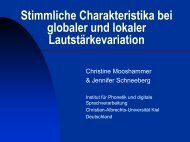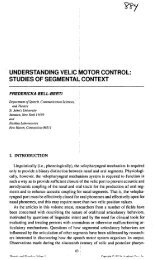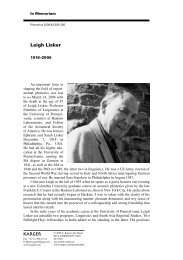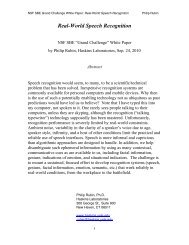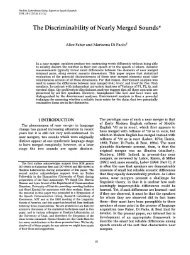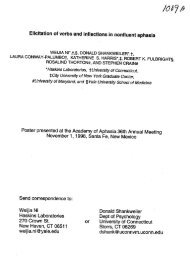Reception of Language in Broca's Aphasia* - Haskins Laboratories
Reception of Language in Broca's Aphasia* - Haskins Laboratories
Reception of Language in Broca's Aphasia* - Haskins Laboratories
You also want an ePaper? Increase the reach of your titles
YUMPU automatically turns print PDFs into web optimized ePapers that Google loves.
144<br />
IAn altemative proposal by Kean (1977) argues that the core problem <strong>in</strong> agrammatism is <strong>in</strong> the<br />
phonological component. Kean supposed that components <strong>of</strong> the language apparatus are<br />
hierarchically organized, with a unidirectional flow <strong>of</strong> <strong>in</strong>formation between levels. Thus, a disturbance<br />
at a lower level <strong>in</strong> the system (Le., the phonology) could masquerade as a breakdown at a higher level.<br />
In this way Kean attempted to expla<strong>in</strong> the nature <strong>of</strong> the apparent "agrammatic" output associated with<br />
nonfluent aphasia. She ma<strong>in</strong>ta<strong>in</strong>ed that the <strong>Broca's</strong> aphasic tends to reduce the structure <strong>of</strong> a sentence<br />
to the m<strong>in</strong>imal str<strong>in</strong>g <strong>of</strong> elements which can be lexically construed as phonological words. This idea can<br />
be extended to account for both their production and comprehension impairments: The <strong>Broca's</strong><br />
aphasic fails to produce or attend to suffixes and other elements which do not occur <strong>in</strong>dependently as<br />
phonological words-elements which are critical for subsequent syntactic and semantic analysis.<br />
Kean's is an elegant attempt to apply l<strong>in</strong>guistic theory to expla<strong>in</strong> a broad set <strong>of</strong> phenomena <strong>in</strong> aphasia.<br />
However, this Viewpo<strong>in</strong>t runs <strong>in</strong>to the difficulty that <strong>Broca's</strong> aphasics are apparently sensitive to the<br />
mean<strong>in</strong>gs <strong>of</strong> many function words (e.g., Lukatela, Cra<strong>in</strong>, & Shankweiler, 1988).<br />
2L<strong>in</strong>ebarger et al. propose that the deficit resides <strong>in</strong> the mapp<strong>in</strong>g relation between the syntax and the<br />
semantics. They advance this "mapp<strong>in</strong>g hypothesis" to expla<strong>in</strong> why their agrammatic subjects'<br />
performance on the grammaticality judgment task surpasses their performance on comprehension<br />
tasks like picture verification (see also Schwartz, L<strong>in</strong>ebarger & Saffran, 1985). This hypothesis is<br />
extended <strong>in</strong> Schwartz, L<strong>in</strong>ebarger, Saffran and Pate (1987) where the deficit is characterized as an<br />
<strong>in</strong>ability to map syntactic functions onto appropriate thematic roles.<br />
3An experiment by Foss (1969) presents an example <strong>of</strong> this phenomenon: it was found that response<br />
times are faster for detection <strong>of</strong> a target phoneme that comes late <strong>in</strong> a sentence, <strong>in</strong> comparison to one<br />
that comes early. It was Foss's view that this pattern required a structural explanation. Holmes and<br />
Forster (1970) reported the same pattern with a click-monitor<strong>in</strong>g task, but they propose a different<br />
<strong>in</strong>terpretation, attribut<strong>in</strong>g the longer reaction times for detect<strong>in</strong>g early items to greater process<strong>in</strong>g load<br />
at-the early stages <strong>of</strong> sentence process<strong>in</strong>g than at later stages. The <strong>in</strong>equality comes about putatively<br />
because at the beg<strong>in</strong>n<strong>in</strong>g the subject is carry<strong>in</strong>g out two tasks at the same time: mak<strong>in</strong>g a decision<br />
about a target word and, <strong>in</strong> addition, process<strong>in</strong>g the words that follow the target word. But if the<br />
detection <strong>of</strong> a target item is on-l<strong>in</strong>e, then it is unclear why vary<strong>in</strong>g the position <strong>of</strong> the target word should<br />
affect process<strong>in</strong>g time <strong>in</strong> any systematic way.<br />
The <strong>in</strong>terference account also predicts that there should be no difference between detection tasks that<br />
present grammatically structured material and those that present unstructured word str<strong>in</strong>gs. But just<br />
this difference has been reported repeatedly <strong>in</strong> the literature. Marslen-Wilson and Tyler (1980) and<br />
Marslen-Wilson (1984) demonstrated that the word position effect is obta<strong>in</strong>ed with syntactically<br />
organized material, but it does not occur with syntactically scrambled word str<strong>in</strong>gs. Moreover,<br />
Aaronson (1968) reported that for presentation rates appropriate to conversational speech, response<br />
time to detect a target segment does not decrease but actually <strong>in</strong>creases with serial position <strong>in</strong> a list <strong>of</strong><br />
unrelated words. These f<strong>in</strong>d<strong>in</strong>gs suggest that the word position effect occurs only with syntactically<br />
organized material. Taken together, they lend considerable support to Foss's view that the word<br />
position effect reflects the process<strong>in</strong>g <strong>of</strong> structure.<br />
4For proposals <strong>of</strong> this k<strong>in</strong>d to pay dividends it must turn out that agrammatism represents an underly<strong>in</strong>g<br />
unity, theoretically and empirically. From the standpo<strong>in</strong>t <strong>of</strong> theory, the notion <strong>of</strong> agrammatism must be<br />
characterized with<strong>in</strong> a viable model <strong>of</strong> language performance; that is, it should conform to natural<br />
seams <strong>in</strong> the language apparatus. It is clear from the work <strong>of</strong> Grodz<strong>in</strong>sky (1984b), Kean (1980; 1982) and<br />
Lapo<strong>in</strong>te (1983) that the phenomenon associated with agrammatism, the <strong>in</strong>correct use <strong>of</strong> the closedclass<br />
morphology, satisfies this criterion.<br />
Badecker and Caramazza (1985) question the status <strong>of</strong> agrammatism as an empirical entity <strong>in</strong> view <strong>of</strong><br />
significant variations <strong>in</strong> language performance among aphasic <strong>in</strong>dividuals so designated. This is not<br />
the place for a discussion <strong>of</strong> the issues raised <strong>in</strong> their critique (see Caplan, 1986). We would po<strong>in</strong>t out<br />
that although we do not accept their conclusion that the concept <strong>of</strong> agrammatism should be jettisoned,<br />
we share a concern with the problems for classification that are created by <strong>in</strong>tersubject variation, and<br />
we concur that the practice <strong>of</strong> group<strong>in</strong>g data over subjects should never be undertaken lightly.<br />
Sfu2nkweiler et al.






